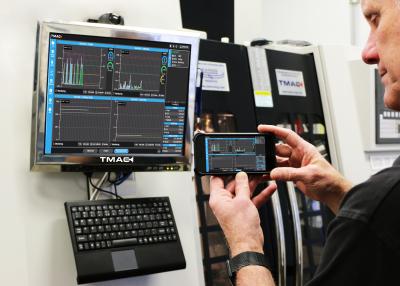
Caron Engineering has announced a major update release of their Tool Monitoring Adaptive Control system, TMAC version 3.0.
TMAC is a real-time tool wear detection system that uses high-precision, multi-range sensors to determine if a tool is worn or broken. Caron Engineering sensors are 10 times more sensitive than other sensors on the market, allowing TMAC to cover a wider range of tools. TMAC has a separate high-speed processor that collects data at 200 times per second, and directly interfaces with any CNC control, to react instantly to wear and extreme conditions.
TMAC 3.0 has been completely redesigned with an intuitive streamlined user-interface that offers numerous configurations for viewing tool monitoring and sensor data. The TMAC system processor now houses its own web server, making the HMI (human-machine interface) browser-based, which enables real-time monitoring from any network connected device. Users (with assigned permissions) have live access to all TMAC systems on a shop floor from a single browser. Securities and permissions can be customized for each user to assign system access based on their user role and job function.
TMAC has an adaptive control mode that optimizes cutting with changing conditions due to wear, variations in material hardness, consistency, and depth of cut. Using a power sensor to monitor motor power, TMAC overrides the machine tool feedrate to maintain a constant spindle motor power during cutting. This enables TMAC to increase the feedrate with low power cuts and decrease with high power cuts, and as tools wear. No operator intervention is necessary when TMAC is monitoring and controlling, making it ideal for unattended operations. Users will see an immediate increase in productivity, extended tool life, and overall reduction in cycle time (up to 60%). Cycle time savings are most significant with hard and difficult to machine materials.
In addition to power, TMAC monitors sensors for vibration, strain, coolant pressure and flow, and spindle speed. The newly enhanced HMI has expanded the monitoring capabilities with TMAC. Users can customize views to show up to 4 sensor channels simultaneously in a single view. For example, the user can set up a single (split-screen) view to monitor power, vibration, spindle speed, and coolant for a specific tool and section at the same time; and have unique limits for each sensor and channel. A user can create unlimited views to show data in a variety of ways, and easily toggle between views during monitoring. Using a vibration sensor TMAC also monitors spindle bearing health, with the analysis initiated by calls in the CNC program.
The TMAC data viewer and event log stores all cutting data and events. Any number of data files can be opened simultaneously to easily view graphical differences and allows overlaying cutting data to compare and analyze cuts.
“TMAC’s universal interfacing compatibility with any CNC control allows us to not only monitor processes and detect anomalies, but make real-time automatic (corrective) adjustments, without the need for human intervention. This is true of all Caron products,” said Rob Caron, President of Caron Engineering.
Contact Details
Related Glossary Terms
- computer numerical control ( CNC)
computer numerical control ( CNC)
Microprocessor-based controller dedicated to a machine tool that permits the creation or modification of parts. Programmed numerical control activates the machine’s servos and spindle drives and controls the various machining operations. See DNC, direct numerical control; NC, numerical control.
- coolant
coolant
Fluid that reduces temperature buildup at the tool/workpiece interface during machining. Normally takes the form of a liquid such as soluble or chemical mixtures (semisynthetic, synthetic) but can be pressurized air or other gas. Because of water’s ability to absorb great quantities of heat, it is widely used as a coolant and vehicle for various cutting compounds, with the water-to-compound ratio varying with the machining task. See cutting fluid; semisynthetic cutting fluid; soluble-oil cutting fluid; synthetic cutting fluid.
- depth of cut
depth of cut
Distance between the bottom of the cut and the uncut surface of the workpiece, measured in a direction at right angles to the machined surface of the workpiece.
- hardness
hardness
Hardness is a measure of the resistance of a material to surface indentation or abrasion. There is no absolute scale for hardness. In order to express hardness quantitatively, each type of test has its own scale, which defines hardness. Indentation hardness obtained through static methods is measured by Brinell, Rockwell, Vickers and Knoop tests. Hardness without indentation is measured by a dynamic method, known as the Scleroscope test.
- web
web
On a rotating tool, the portion of the tool body that joins the lands. Web is thicker at the shank end, relative to the point end, providing maximum torsional strength.
